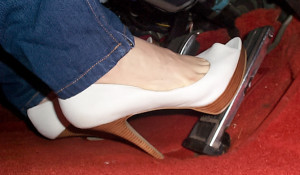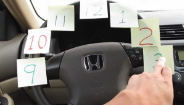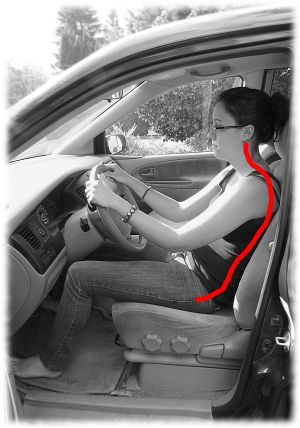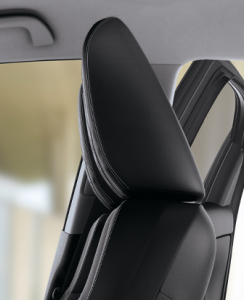(Updated With New Tips)
Here are 8 Tips To Prevent Sciatica and Piriformis Syndrome While Driving
If you want to prevent sciatica while driving the following tips are essential because traveling with sciatica can be excruciating.
The sciatic nerve is the longest nerve in the body. It actually starts as five nerve roots in the lower back.
If you are experiencing sciatic pain that starts in the lower back you have sciatica.
Deep in your butt– right where you sit– these nerve roots meet to form the sciatic nerve. In the same spot, there is a muscle called the piriformis.
At the place the sciatic nerve forms in front of the piriformis it is the thickest nerve in the body.
When you have sciatic pain that starts in the butt it is called piriformis syndrome. I think it is very important to know the difference.
And it is equally important that you know what you are dealing with.
Traveling from the lower back to the foot there are many places along the sciatic nerve that can suffer.
When the sciatic nerve is most unhappy your foot can go numb which we hope to avoid at all costs.
And in the context of this post, car seats are not well designed– especially for women’s bodies.
Honestly, the design of car seats doesn’t matter for most people. But for those who are in pain, getting into a car seat can be like getting into an iron maiden.
I learned about sciatica and piriformis syndrome intimately when my body broke down and I went through extensive physical therapy.

I don’t have sciatica now, but, hour after hour behind the wheel can still put terrible demands on my body. So I devised a number of strategies for driving and surviving.
I hope they help.
Tip #1- Getting in and out of a Car When You Have Sciatica

To avoid sciatica while driving you have to start the journey correctly.
Unfortunately, the pain from sciatica and piriformis syndrome can be triggered before you turn the car on.
The sciatic nerve passes through the pelvis so keeping the pelvis well aligned is super important.
The function of the piriformis muscle is to turn the leg out and pull the leg to the side when the hip is flexed. Which is the exact act of getting in and out of a car.
I often return to those annoying people who don’t suffer from pain. They get in and out of a car without thinking about it.
One leg goes in spreading the legs wide which can tweak the sciatic nerve and piriformis muscle.
Getting out of the car is the same in reverse. One leg out and then the other.
A serious problem with sciatic nerve pain is that once the pain kicks in you have lost the battle if not the war.
While changing habits is not easy pain is a great incentive.
So here is your new way to get in and out of a car.
By keeping the legs together and the pelvis aligned, there is less chance to mess with the sciatic nerve.
And if you start your drive without pain you just might stay that way.
Tip #2 - Put Your Left Foot On The Foot Pad
One way to cope with sciatica pain while driving is to use your car as designed.
There is a pad for your left foot that is a feature in every car.
You want to make use of this a majority of the time you are driving.

I can’t expect you to do it all of the time but try and remember a few times every drive. It is a great habit to develop.
The left footpad allows both legs to be relatively extended and in a similar position. This gives you the best chance to maintain a balanced pelvis.
The position of your pelvis determines how well the sciatic nerve can pass through it.
Your knee will be slightly bent depending on how near or far from the steering wheel your seat is situated.
People adjust their seats for different reasons (See Tip #7 ). In general, I don’t think it is great to be too close to the steering wheel.
Giving the legs a little room to lengthen is a good choice.
Unfortunately, there are a number of bad choices available for the left leg.
Keeping the foot flat on the floorboard, with the knee bent, instead of on that pedal, flexes the hip.
It would be better to avoid flexing that hip for too long.
I have also seen people crossing the left foot both over and under the right thigh. Don’t do that!
It’s best to be nice to your left leg and keep your left foot on the pedal provided.
Tip #3 - The Right Heel Stays In Line With The Gas Pedal
One way how to drive comfortably with sciatica is to keep the piriformis muscle happy.
It’s hard to say which are the most important tips to prevent sciatica and piriformis syndrome. Each of these is truly essential if you are in pain.
But keeping the right foot parallel on the gas pedal is key. It keeps the piriformis muscle in a neutral position and therefore less likely to freak out.

There is a tendency for the heel of the right foot to sit between the gas and brake pedals. From there, you likely use the heel as a pivot between the gas and brake.
But as I mentioned earlier, the piriformis is an external rotator. It turns the leg out. Imagine driving for an hour, and think how many times you might turn your foot in and out.
Over many hours, or even minutes for some, this constant internal and external rotation can tweak the piriformis.
Especially when you go to use the brake after a long time on the gas pedal.
I can’t tell you how many injuries happen in transition like this. You hold a position, whether sitting or standing, for too long, and then move too quickly.
That is actually the origin of so many injuries.
So it is best to keep the heel directly in line with the bottom of the gas pedal.
Then shift the whole foot and leg to the brake, and then back to the gas. This maintains a parallel alignment of the right foot.
I know this might seem maddening after years of driving a certain way but the payoff is great.
Change isn’t easy but is often worth it.
Tip #4 - Keep Your Hands At Nine And Three
Most people don’t think about their arms when they are considering how to avoid sciatic pain when driving.
Considering that pain from sciatica and piriformis syndrome is below the lower back you might think they have a good reason.
But the essential space between the pelvis and ribcage needs to be in balance when we drive.

If you hold your hands at nine o’clock and three o’clock on the steering wheel you are creating that balance.
Just like keeping the left leg in a similar position to the right, you want both hands to also be in balance.
It’s all about creating the best environment for the pelvis to preserve good positioning for the sciatic nerve to flow.
Driving one-handed should be avoided because it allows for assorted misalignments and permutations of the trunk. It leaves the arms free to perform two completely different actions.
Let's look at the archetype of the American male driver. The right hand is on the top of the wheel and the left elbow rests out an open window.
This position tends to lengthen the right side and shorten the left.
Another option for imbalance is putting the left hand on the wheel and the right elbow on the middle console. You will likely collapse to the right side a bit.
Your best option is to keep your hands at nine o’clock and three o’clock. This treats the sides of your waist, and your sciatic nerve kindly.
Tip #5 - A Curve in the Lower Back
Tips to prevent sciatica and piriformis syndrome sometimes involve body parts you can’t see or feel. In this case, we are talking about the spine. The amazing human spine.
There are four curves in the human spine. The neck and the lower back curve in, and these curves are what allow us to stand and walk upright.
The curves aren’t fixed or permanent. They are supple and require muscle tone to be maintained.
And one important way how to prevent sciatica while driving is to find, and keep, that curve in your spine.
This is one of the main problems with bucket seats in cars. Even those with lumbar support encourage your pelvis into a poor position.

The pelvis tends to tuck under and the lower back tends to meld with the seatback.
Every effort to avoid this and any attempt to find the best position for the spine can pay great dividends.
The ability to maintain this good posture requires core muscle tone that some people have and others need to develop.
The resting muscle tone that we have before we get into the car is key. It determines how long we can drive in an optimal position once we are on the road.
If you don’t have the muscle tone and strength required you might actually need to fake it before you make it so that you can keep your lower spine curved in the correct way.
In general, it is better to build muscle tone that serves through exercise. But until you get there, gentle muscular engagement is sometimes helpful.
Once we lose the alignment of the spine and/or tuck the pelvis when driving, we are in harm’s way. And this poor alignment puts the sciatic nerve and piriformis muscle into a very vulnerable position.
Tip #6 - Put Your Head On the Headrest
Above the trunk, we have the head, a heavy structure balanced precariously on top of the spine.
The heaviness of the head makes it hard to align it successfully. It simply wants to move forward.
Mostly due to the poor arrangement of the skeleton below the neck.
Forward head posture is a problem for almost everyone I work with.

I have it and I have been working to change my posture for a very long time.
And I don’t think you will be surprised to hear me say that car seats make forward head posture worse.
Headrests in particular.
Headrests in the newer model cars are positioned to protect against whiplash in an accident.
This is accomplished by keeping the headrest so far forward there is less room for the head to snap back on impact.
That shoves your head forward by design. And trust me when I tell you that your forward head was a problem before you got in the car.
The design is meant to, and does, reduce whiplash injuries. But the cost to the position of our head and neck is not in any way worth it to me.
Especially if you drive for long periods of time.
But no matter where your headrest resides, the back of your head should be against it.
You should be lengthening the back of the neck so that the base of your head is on the headrest.
Tip #7 - Adjust Your Seat (A Little)
This tip to prevent sciatica and piriformis syndrome might seem counterintuitive.
But when you’re trying to figure out how to drive with sciatic nerve pain the obvious doesn’t always work.
It is also a tip that mostly applies to long drives.
In Tip #2 (Put Your Left Foot On the Foot Pad) I said your leg should be able to extend comfortably.
This is still true but when it comes to pain, stillness is often an adversary.

Doing anything in one position for too long can lead to trouble.
A lot of injuries occur after we sit or stand longer than we should and then move.
So this is also a reminder to pay attention to Tip #1 (Getting In & Out of a Car With Sciatica).
Imagine the last leg of a long car ride. Most people are going to gas up and/ or eat before they finish the drive.
So it might be 60 minutes of driving, maybe 90 minutes, or even more?
And then you can’t wait to get out of the car, and swing that leg out… and ouch!
One way to counter that is to adjust your seat fairly regularly.
For the most part, you should drive in a position you like. But every once in a while slide the seat one setting forward.
After another while, take the seat back two settings.
And again, after another period of time, return to your preferred position.
These relatively minor adjustments can be very helpful.
Tip #8 - The Cabbie Solution
Ask cab drivers, “Can excessive driving cause sciatica?” and get ready for universal agreement.
Spending too much time in the car is why so many cabbies and truckers get sciatic nerve problems when driving.
It is also why it is worth checking out their solutions.
I grew up in New York where yellow cabs were everywhere. And it seemed like every cab came equipped with these beaded seat covers.
This tip might not appeal to everyone's style but the concept of form over function shouldn’t apply to pain relief.

The soft cushion of a car’s seat seems inviting but when it comes to sciatic pain it’s nothing but trouble.
The sciatic nerve has a long way to travel. Running all the way from the lower back to the foot, our job is to give it the best pathway possible.
A soft seat that welcomes us to sink deep does not do that.
I get that it might seem odd that a hard surface will help with sciatic pain. But that hard surface will allow you to find, and maintain much better alignment.
If there is anything good to say about driving in a car it’s that it is a place to work on your sitting posture.
And pain offers a great incentive to do that work.
We are habitual creatures who tend to find a pattern and stick with it.
Unfortunately, there is nothing that ensures that our behaviors are for the best.
We don’t naturally choose healthy positive patterns when it comes to movement and posture.
Good patterns will only come with awareness and conscious choice.
Start to use your time in the car wisely. Make the most out of a bad situation and develop better posture by sitting in your car.
Tip #9 - A Tennis Ball
You can make great use of a tennis ball while driving.
You can sit on it which can bring relief to your butt and piriformis muscle.
You can put it behind your back in any of many positions which can also be helpful.

Rolling out your feet with the tennis ball is great but particular to people in the passenger seat.
You shouldn't roll your foot out while driving because you can lose contact with the ball and it can roll and get stuck under the gas pedal.
And we wouldn't want that.
If you are driving, stop every hour or so to get out of the car and roll your feet with the tennis ball.
I know this isn't the most convenient option but it is very helpful.
If you are in the passenger seat, roll your feet to your hearts content.
Tip #10 - Where's Your Wallet?
This is a tip mostly for men and it goes for more than just driving.
No one should keep their wallet in the back pocket.
Especially when sitting and driving.

Get into the habit of carrying your wallet in the front pocket and you will be much happier for it.
Wallets in the back pocket create irritation and imbalance. Don't do it.
********
We are habitual creatures who tend to find a pattern and stick with it.
Unfortunately there is nothing that ensures that our behaviors are for the best.
We don’t naturally choose healthy positive patterns when it comes to movement and posture.
Good patterns will only come with awareness and conscious choice.
